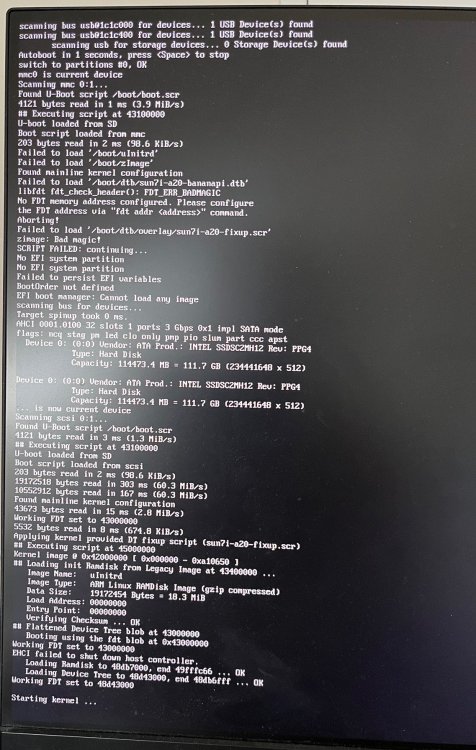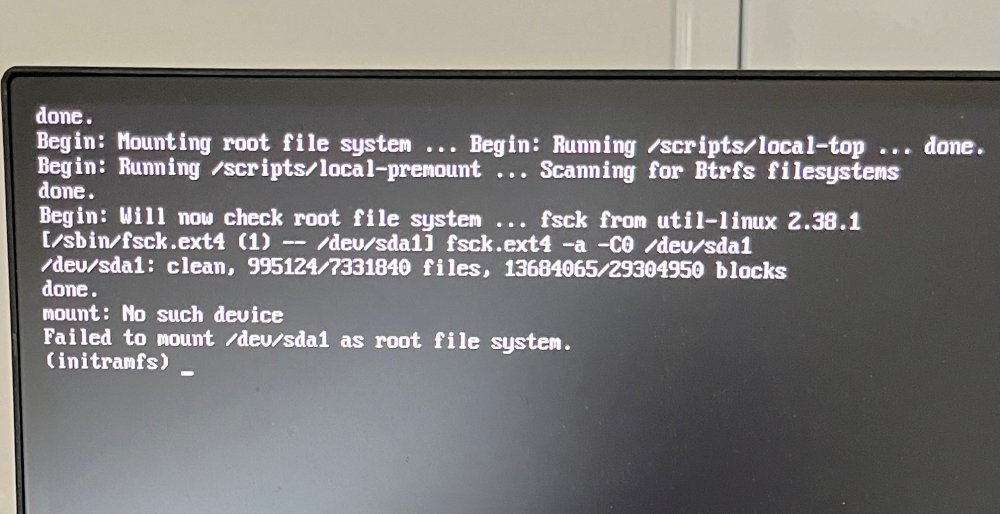Active threads
Showing topics posted in for the last 365 days.
- Past hour
-

How install Armbian to tvbox Ugoos SK1 ( chip S928X-K )
Werner replied to Nguyễn Tất Hùng's topic in Amlogic CPU Boxes
Okay, then you have to adjust the source to mitigate the issue. Also log excerpts are often useless. My random guess is that uboot is some old outdated version depending on python2 which has been deprecated years ago. - Today
-
Hi, yesterday i see a "armbian-update" message after login per ssh. I run this command and than my banana pi M1 won't boot. How can i repair it without formatting the SSD? Regards Christian
-
@StanleyLIM I see it should run a variant of OpenWrt, see https://www.friendlyelec.com/index.php?route=product/product&path=69&product_id=290 My NanoPi-R6C got delivered with that FriendlyWrt pre-installed on eMMC. I bought the R6C as alternative for RPi5, nice metal passive cooling and M.2 M-key as well. FriendlyWrt uses a bunch of partitions to store various objects related to the boot stage and although it would be nice for a router, I wanted generic Linux as base. But R6C is using RK3588S as SoC, yours RK3568B2. Based on experience with my ROCK3A (RK3568), you could first check if both NICs are available on PCI-E, 'sudo lspci' should show. If available, 'sudo ip link' should also show the 2 NICs as network ports. Then it is a matter of high-level networking, not really specific to Armbian.
-

Odroid C4 is using HC4 dtb and odroidhc4 packages
spleeth replied to spleeth's topic in Amlogic meson
To anyone this may help, removing hc4 related packages and replacing them with c4 packages did the job. Only to discover that, for whatever reason, I actually had an HC4 board and convince myself that it was a C4 ... Anyway, the reverse process also worked as expected and my board is now running 25.051.1 happily, except for the samsung SSD not recognized at boot, and requires to be hot plugged just after the linux kernel starts in order to be seen by the system, as it is described in other threads. -

Sipeed LonganPi 3H - No boot due to thermal errors
Mechano replied to Mechano's topic in Allwinner sunxi
They have a repository on Mega and Baidu. https://wiki.sipeed.com/hardware/en/longan/h618/lpi3h/3_images.html - Yesterday
-
As far as I know openvfd needs to be re-worked to support 6.12.y and up. EDIT: I stand corrected. I found a working patch at unifreq. It needs to be patched against the source-tree. 0001-drv-auxdisplay-Add-openvfd-driver.patch
-

Help wanted to test a new OpenVFD alternative
Jean-Francois Lessard replied to Jean-Francois Lessard's topic in Amlogic meson
@KrzyPacu Can you look at your full dmesg output (no filter on tm16xx)? I guess there are some other error messages prior to there filtered output. I don't think that you have a different controller. Maybe rather the pinout: which pins of the SoC of your TV box are wired to the controller and how they are declared in the device tree. Was your display working properly with the OpenVFD driver and the hk1-x3.conf VFD configuration file you posted? If so, the controller is good and it's probably the pin numbers described in the device tree that needs to be adjusted. My hk1-x3.dtso was converted from the OpenVFD configuration file, but the device hasn't been tested yet to my knowledge. So it might need some corrections. -
@junji. Can you explain me how you proceed to boot this OS image Armbian-unofficial_25.05.0-trunk_X96q-lpddr3-v1-3_bookworm_edge_6.12.11_xfce_desktop.img.xz ?
-
For a few weeks I've been using the latest official release from May 26, 2025, running just fine from my NVME drive. But then I turned it on and at the screen where you get the Amrbian grey/red logo in the middle of the screen and the spinning circle, it went no further. The spinning circle would either stop rotating or disappear after a minute or so. I can SSH into the device. But when I use remote desktop from a Windows PC, the full and functioning desktop is there. It's just not on my TV screen any more. I've done the usual HDMI cable testing and powering off the TV completely, but no change. The fact that the desktop is accessible remotely does indicate that it must be loading in some fashion. Took a log here: https://paste.next.armbian.com/qococumoga
-

Kernel 6.12.20 Banana Pi M2 zero USB doesn't work
laibsch replied to Bernd's topic in Allwinner sunxi
Thank you for letting us know, much appreciated. Have you tried to reach out to Michael Hawkins, the maintainer? -
Hello all Is anybody having success with spidev with orange pi zero 3 and Linux 6.12? I want to test my LCD panel's touch, but I need spidev working first
-
You could try to install auditd and check what it says when the event appears. Maybe it will tell you which process is sending the event: $ sudo apt install auditd $ sudo auditctl -w /proc/sysrq-trigger -p w -k sysrq_watch The second command is creating a watch on sysrq-trigger for write events, called sysrq_watch. You can query check this watch with: $ sudo ausearch -k sysrq_watch See what you can find when you detect another trigger of the sysrq key.
-
Hi again, one quick question -- I previously made the mistake of running apt upgrade of the system packages and had installed armbian-configNG over the included armbian-config, so I basically nuked the SD card and reinstalled the image to roll back to the old config. This likely has been covered, but is there a way to reinstall armbian-config or is this a known issue and "DON'T UPGRADE" ? Cheers!
- Last week
-
It's a progress! This or similar problem was seen / reported on H3 too.
-
Here is a more vanilla build of the kernel. patrick@bananapim4zero:~$ ls /dev/ttyS* /dev/ttyS0 /dev/ttyS3 /dev/ttyS5 /dev/ttyS7 /dev/ttyS2 /dev/ttyS4 /dev/ttyS6 patrick@bananapim4zero:~$ sudo rfkill ID TYPE DEVICE SOFT HARD 0 bluetooth hci0 unblocked unblocked 1 wlan phy0 unblocked unblocked patrick@bananapim4zero:~$ bluetoothctl hci0 new_settings: powered bondable ssp br/edr le secure-conn Agent registered [CHG] Controller AC:6A:A3:3B:D9:D6 Pairable: yes [bluetoothctl]> exit patrick@bananapim4zero:~$ uname -a Linux bananapim4zero 6.12.32 #1 SMP Sat Jun 7 17:23:51 EDT 2025 aarch64 GNU/Linux patrick@bananapim4zero:~$ dmesg | grep brcm [ 9.007064] brcmfmac: brcmf_fw_alloc_request: using brcm/brcmfmac43455-sdio for chip BCM4345/6 [ 9.007614] usbcore: registered new interface driver brcmfmac [ 9.303238] brcmfmac: brcmf_c_process_txcap_blob: no txcap_blob available (err=-2) [ 9.303576] brcmfmac: brcmf_c_preinit_dcmds: Firmware: BCM4345/6 wl0: Aug 29 2023 01:47:08 version 7.45.265 (28bca26 CY) FWID 01-b677b91b [ 9.430799] Bluetooth: hci0: BCM4345C0 'brcm/BCM4345C0.sinovoip,bpi-m4-zero.hcd' Patch As you can see the Bluetooth works fine. If I add these two patches it breaks bluetooth on this kernel build. drv-rtc-sun6i-support-RTCs-without-external-LOSCs.patch drv-rtc-sun6i-Add-Allwinner-H616-support.patch I'm still investigating in my spare time, but I'm not 100% on anything. Could be I need to take another approach to the bluetooth node in Armbian? So this is where am at. If anyone has any thoughts I'm all ears.
-
@Angel Luis Pérez Your image save my life! I just got the Radxa Cubie A5E and surprisingly found that this two eth ports board factory image doesn't include tun.ko I dig some other same T527/A527 boards image but none of them has tun.ko from 5.15 kernel, except yours! I am about to export the tun.ko to Cubie A5E's factory image to see if it works.
-
I consider the btrfs issue 'solved', from past experience I know sometimes explicit balancing is needed for certain blockdevice level or lowlevel operations, like conversion of profiles, for example single into raid1, there must be enough unallocated space so new 1GB chunks can be created, especially on the originating device as it is all fundamentally copy-on-write so at least extra/double space for 1 system, meta, data chunk shall be available and I simply forgot to check/realize that. Further enhancements to Btrfs that this is done automatically somehow means likely that I first need to browse the kernel mailing list and see what people like David Sterba are doing nowadays. The CMA issue I suspect maybe it is related to power supply. Because of testing, I needed to take the NanoPi-R6C to another room where i used a 65W 'white-label branded' USB-C PD PSU that I got delivered with a refurbished laptop. That PSU has once shown under-voltage on an RPi4, so I expect too much ripple (when 5V). Besides the CMA issue, lateron also sudden hard reset of the NanoPi-R6C when I was doing networked backup, was 2x ethernet + HDMI + NVMe + eMMC active and that could mean >3A when only 5V. When I also took my RPI5 27W USB-C PD PSU to that room and used that, no strange issues anymore, so running fine at least with EDK2-UEFI and Armbian kernel 6.15.2-edge-rockchip64 and Bookworm or Tumbleweed userspace (and KDE Wayland). I have never seen PD working on the NanoPi-R6C and the powering circuit looks a lot like ROCK3A w.r.t. staged DC-DC conversion. And I use Armbian mainline based U-Boot or EDK2-UEFI, not the original FriendlyWrt installation with some 2017 based U-Boot. Also for that original one, I doubt that it does USB-C PD to request 9V or higher. I assume not, looking at: https://wiki.friendlyelec.com/wiki/index.php/NanoPi_R6C#PD_Power_Adapters_We_Tested https://wiki.friendlyelec.com/wiki/index.php/Template:PDPowerWeTested There is also nothing about USB-C PD under https://www.friendlyelec.com/Forum/viewforum.php?f=81 so I assume: Great HW but SW/OS support is abandoned and DIY. That also means, same as for ROCK3A and ROCK5B, solder some 12V wire to a male USB-C connector and use that in order to be sure power won't drop too much when e.g. some USB3 HDD/SSD is inserted. Or limit cables to only RPI5 PSU and WAN/1GB ethernet (and still Samsung 970 NVMe, that works OK, even when 800% CPUload). Or check/see if PD handling is available in denx.de/mainline U-Boot.
-
Yes exactly
-

Cubieboard 1 - No display output when booting Debian 12 image
Shakai2 replied to Shakai2's topic in Allwinner sunxi
Thank you for the reply ! I see — is there any version of Armbian or another distro that has working HDMI output and graphics drivers ? -

Armbian for an old Allwinner A10 tablet
Ryzer replied to thewiseguyshivam's topic in Allwinner sunxi
Hi, Then the only other difference would be that your device has a pin tied to usb0-vbus. The topwise dts does not have the display nodes included in the cubieboard. Now as you are currently kernel 6.1, it is possible to enable the display via overlays or compile a version of the topwise dts that includes the display nodes. So the internal display does not work under 6.1? Are there any kind of errors or does it not appear to intialise at all? Cubieboard nodes (*Note - Nodes other than hdmi and usb related have been removed): /dts-v1/; #include "sun4i-a10.dtsi" #include "sunxi-common-regulators.dtsi" #include <dt-bindings/gpio/gpio.h> / { model = "Cubietech Cubieboard"; compatible = "cubietech,a10-cubieboard", "allwinner,sun4i-a10"; hdmi-connector { compatible = "hdmi-connector"; type = "a"; port { hdmi_con_in: endpoint { remote-endpoint = <&hdmi_out_con>; }; }; }; }; &de { status = "okay"; }; &hdmi { status = "okay"; }; &hdmi_out { hdmi_out_con: endpoint { remote-endpoint = <&hdmi_con_in>; }; }; ®_usb1_vbus { status = "okay"; }; ®_usb2_vbus { status = "okay"; }; &usb_otg { dr_mode = "otg"; status = "okay"; }; &usbphy { usb0_id_det-gpios = <&pio 7 4 (GPIO_ACTIVE_HIGH | GPIO_PULL_UP)>; /* PH4 */ usb1_vbus-supply = <®_usb1_vbus>; usb2_vbus-supply = <®_usb2_vbus>; status = "okay"; }; Topwise a721: /dts-v1/; #include "sun4i-a10.dtsi" #include "sunxi-common-regulators.dtsi" #include <dt-bindings/gpio/gpio.h> #include <dt-bindings/input/input.h> #include <dt-bindings/interrupt-controller/irq.h> #include <dt-bindings/pwm/pwm.h> / { model = "Topwise A721"; compatible = "topwise,a721", "allwinner,sun4i-a10"; panel { compatible = "starry,kr070pe2t"; backlight = <&backlight>; power-supply = <®_lcd_power>; port { panel_input: endpoint { remote-endpoint = <&tcon0_out_panel>; }; }; }; reg_lcd_power: reg-lcd-power { compatible = "regulator-fixed"; regulator-name = "reg-lcd-power"; gpio = <&pio 7 8 GPIO_ACTIVE_HIGH>; /* PH8 */ enable-active-high; }; }; &de { status = "okay"; }; ®_usb0_vbus { status = "okay"; }; ®_usb1_vbus { status = "okay"; }; ®_usb2_vbus { status = "okay"; }; &tcon0_out { tcon0_out_panel: endpoint@0 { reg = <0>; remote-endpoint = <&panel_input>; }; }; &usb_otg { dr_mode = "otg"; status = "okay"; }; &usb_power_supply { status = "okay"; }; &usbphy { usb0_id_det-gpios = <&pio 7 4 GPIO_ACTIVE_HIGH>; /* PH4 */ usb0_vbus_det-gpios = <&pio 7 5 GPIO_ACTIVE_HIGH>; /* PH5 */ usb0_vbus-supply = <®_usb0_vbus>; usb1_vbus-supply = <®_usb1_vbus>; usb2_vbus-supply = <®_usb2_vbus>; status = "okay"; }; It is possible to build just uboot using the BUILD_ONLY=uboot option. Again here you could face potential issues as newer uboot might not work well with an old kernel. All the best Ryzer -

Orangepi Zero 2W wrong color display on MPI3501
robertoj replied to Minh Tiến Nguyễn's topic in Allwinner sunxi
You can build an armbian image with these instructions:https://docs.armbian.com/Developer-Guide_Build-Preparation/ You can configure it: https://docs.armbian.com/ When you have a setup you like, use this to backup as an image: https://forum.armbian.com/topic/29427-shrink-backup-a-tool-for-backing-up-sbcs/ I still suggest only armbian... but please share if you can use buildroot for opiz2w -
It is Allwinner H618, Quad-core ARM Cortex™-A53 processor. I meant which Eth chip is used in your case Bananapi-m4-berry: h618 ==> Eth chip rtl8211f ==> connecting socket Bananapi-m4-zero: h618 ==> Eth chip ???? ==> connecting socket As far as I understand, this is some kind of expansion card for the 26 pin connector. Can you post a diagram of this expansion board here. The brand of the Ethernet chip matters.







